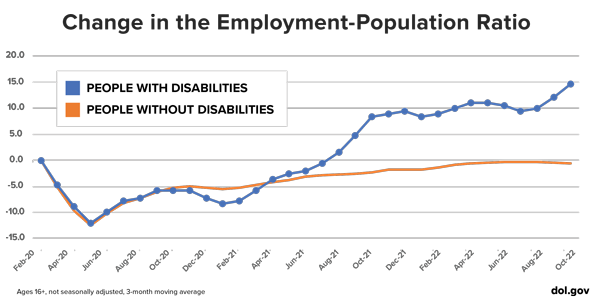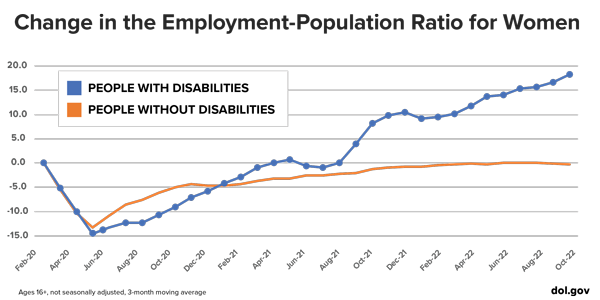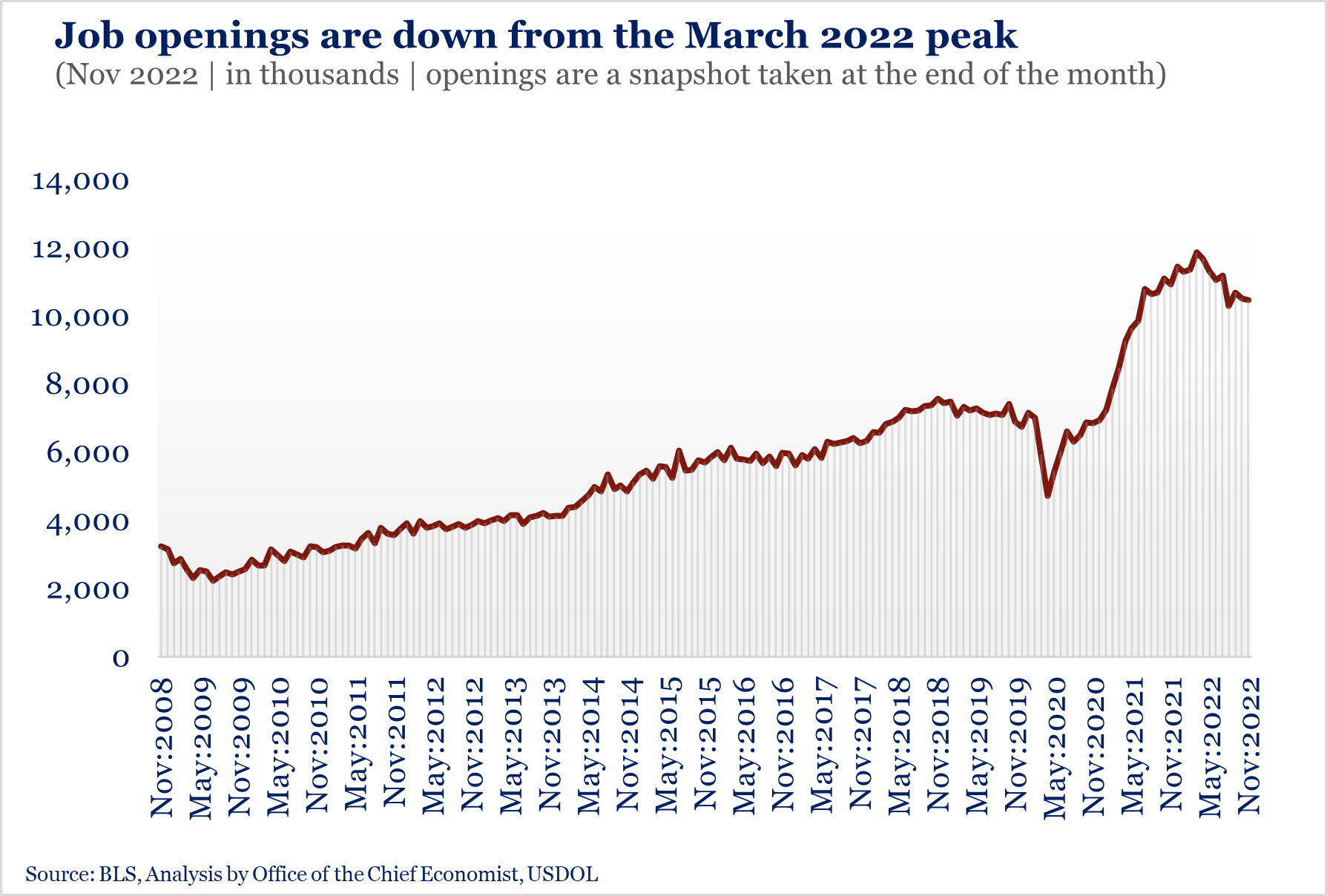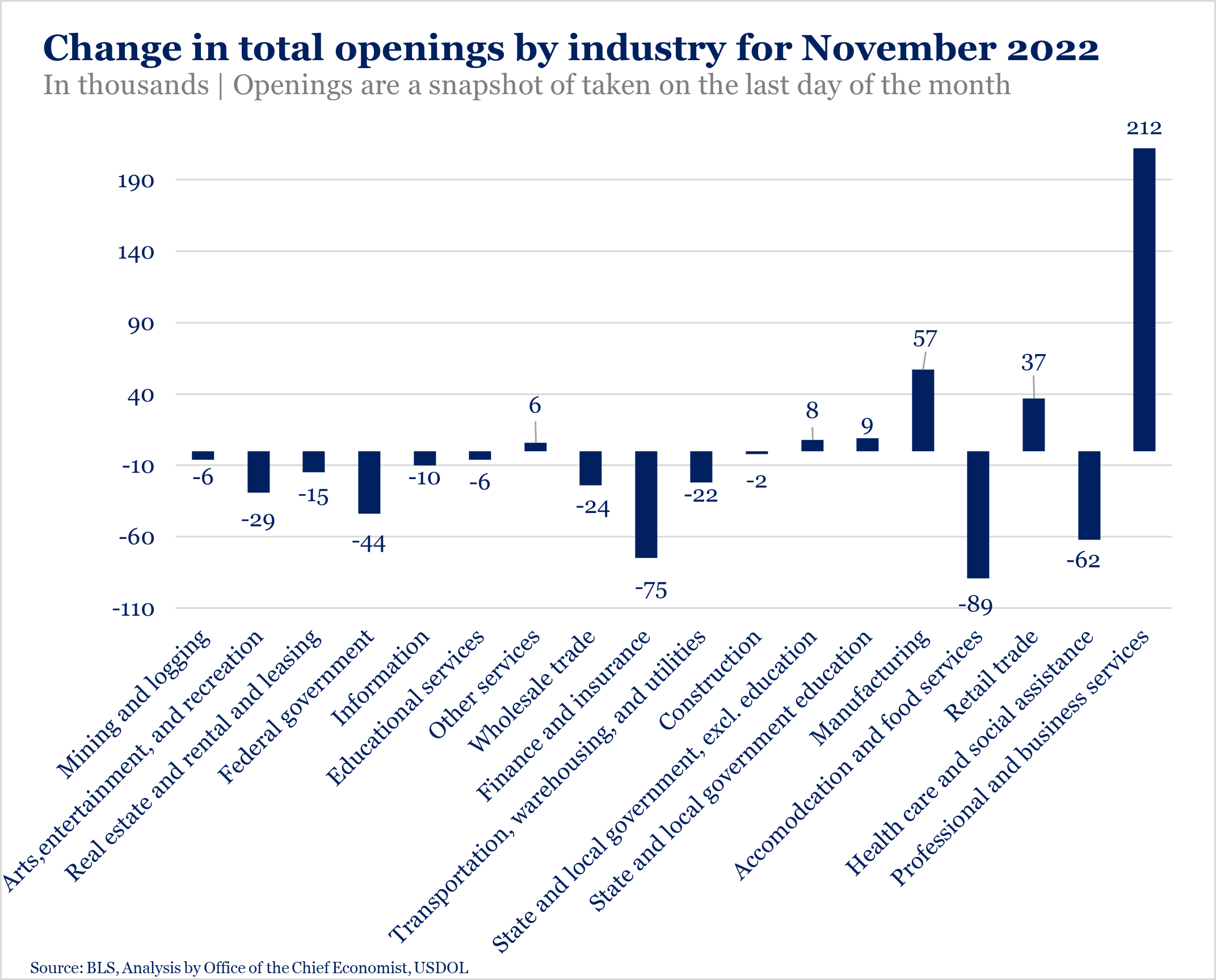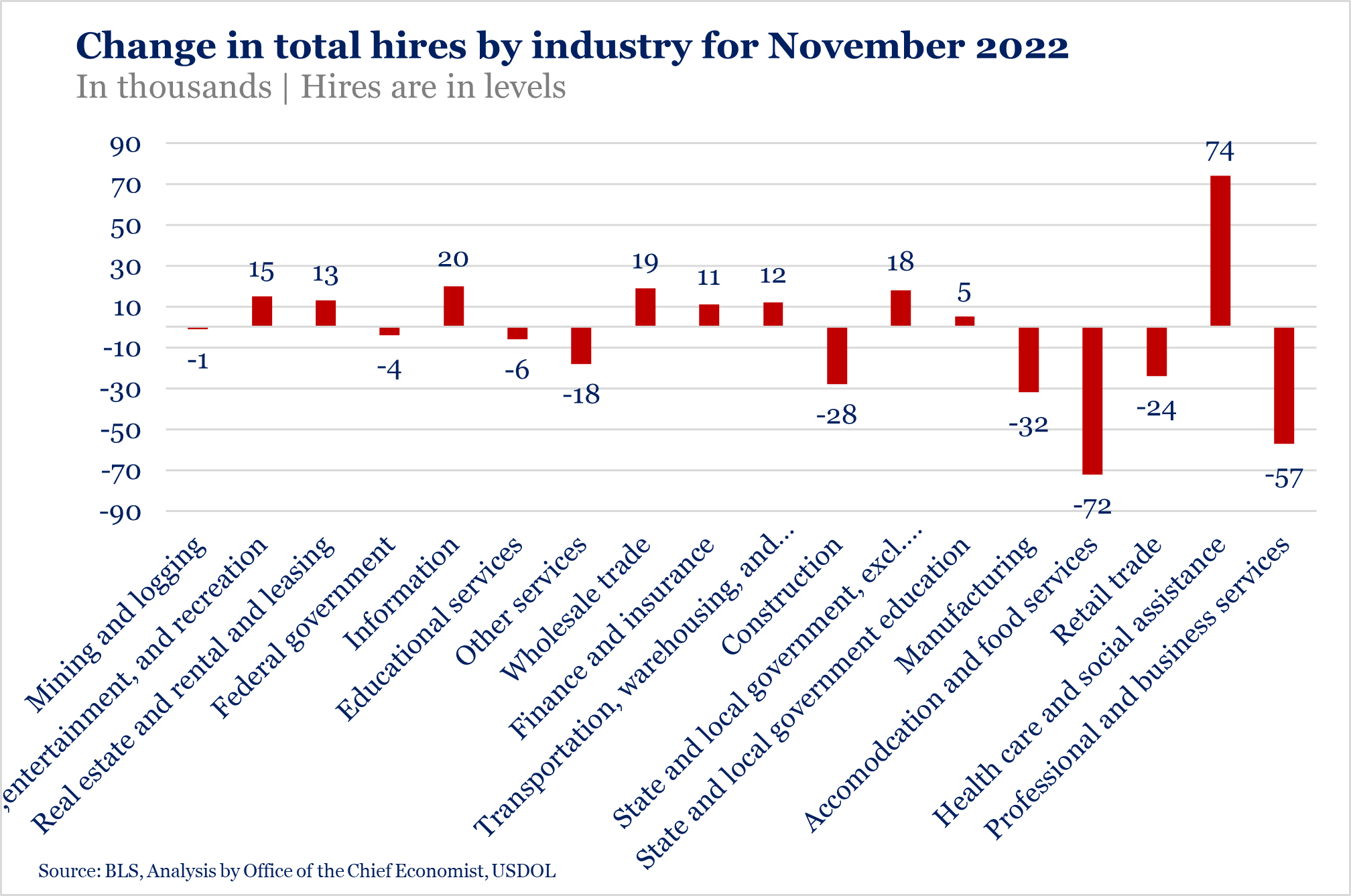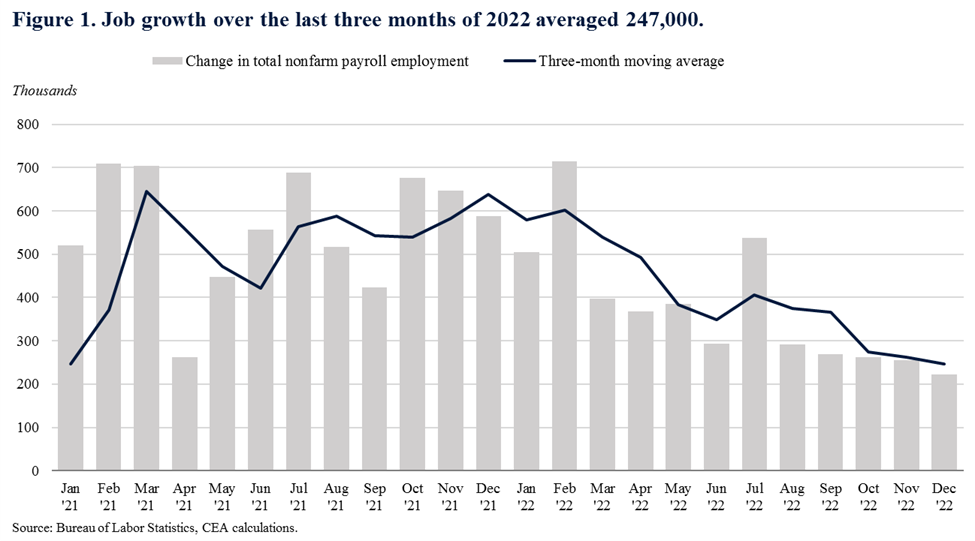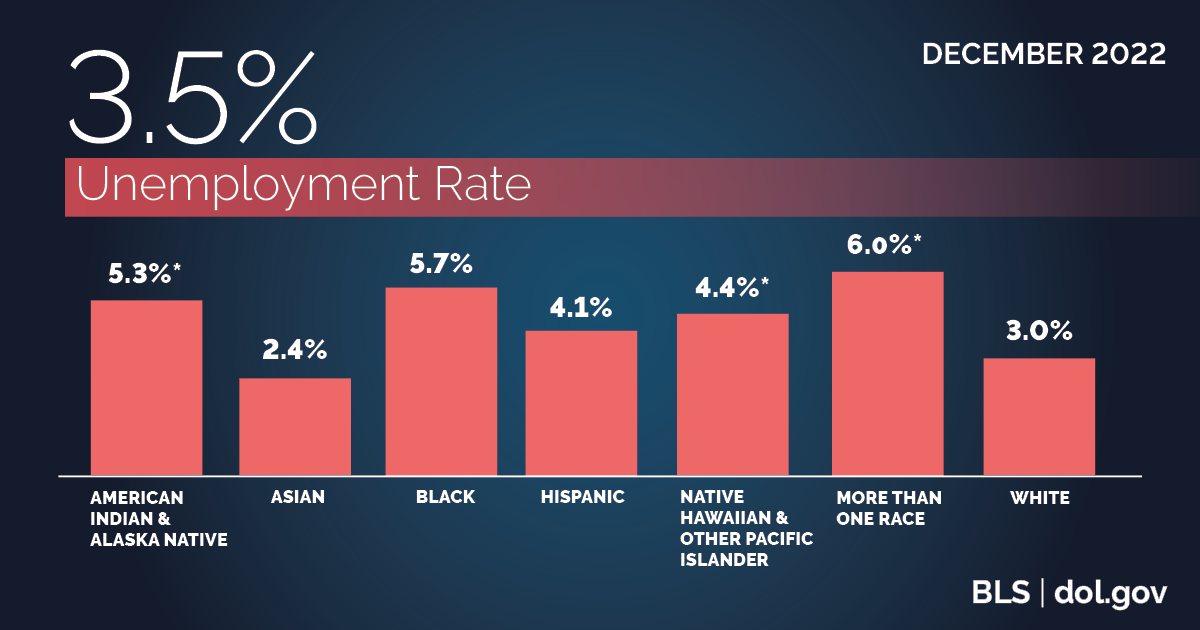
- Once again, USDOL Secretary Used Prior Secretary Scalia’s Order 01-2020 to Intervene in an OFCCP Administrative Action
- President Biden Formally Re-Nominated Gilbride (EEOC Counsel) & Kotagal (EEOC Commissioner)
- House Republicans Proposed Procedural Rules That Would Allow Legislative Amendments to Axe Specific Programs/Agencies or Agency Officials
- Increased Employment for People with Disabilities Likely Due to Pandemic Operational Changes, New USDOL Blog Asserted
- U.S. BLS Reported Slight Decrease in Job Openings for November, Little Change in Hires & Total Separations
- White House Office of Management & Budget Released Fall 2022 Regulatory Agenda
- U.S. Federal Trade Commission Announced Proposal to Ban Employers from Using Worker Non-Compete Agreements
- Economy Added 223k Jobs in December; Unemployment Rate Remained at 3.5%
- Looking Ahead: Upcoming Date Reminders
Friday, December 23, 2022: Once again, USDOL Secretary Used Prior Secretary Scalia’s Order 01-2020 to Intervene in an OFCCP Administrative Action
Secretary Reversed ARB/ALJ Rulings and Made New Rules for Remedies for Discrimination Claims
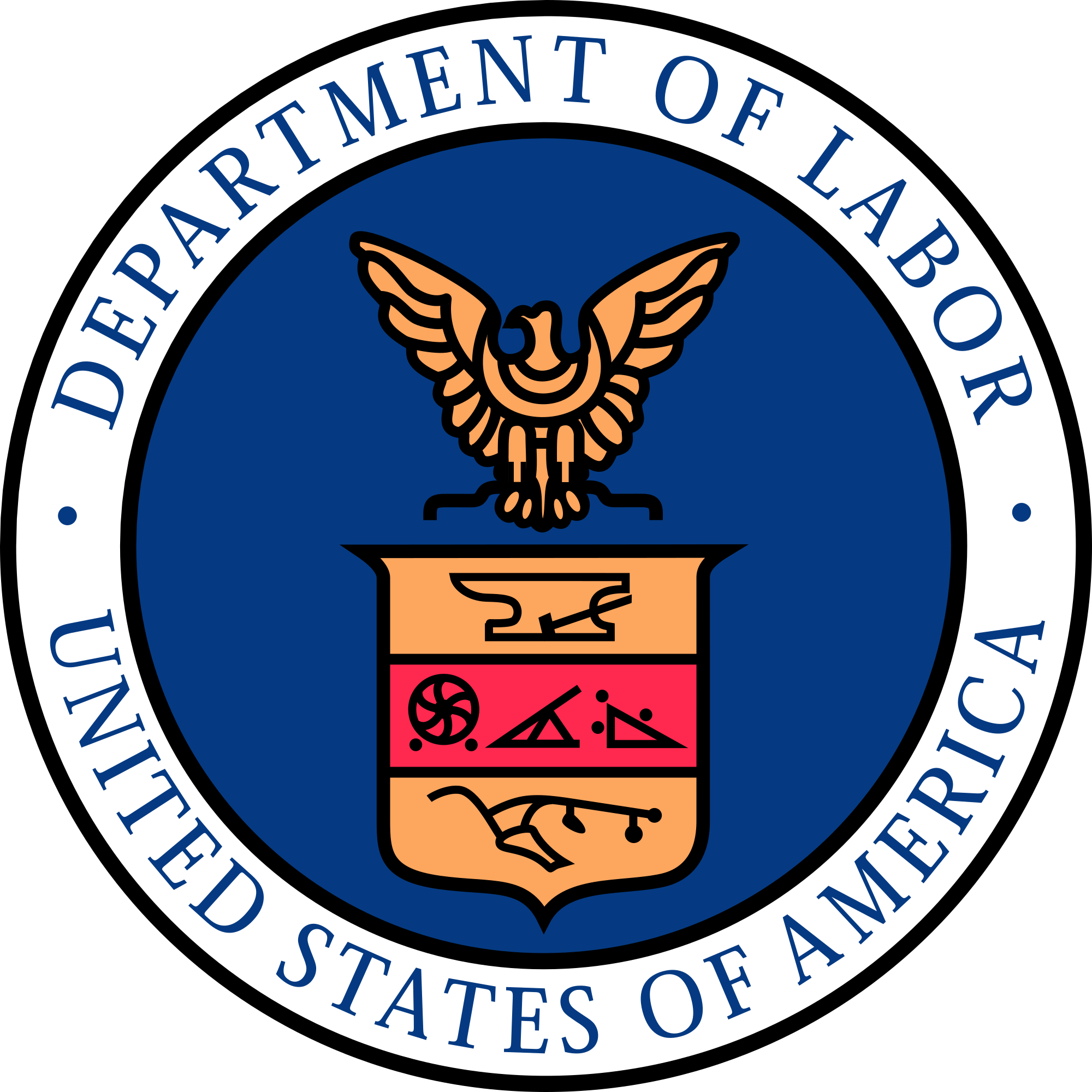
ALJ Had Found Contractor Liable for Multiple Acts of Discrimination & Harassment
WMS Solutions, LLC (WMS) is a Baltimore-based staffing agency specializing in asbestos removal and demolition. The company supplies workers for federal prime construction contractors at the contractors’ construction sites. On May 12, 2020, Administrative Law Judge (ALJ) Larry S. Merck issued a 90-page Recommended Decision and Order (“RDO”) in the case. ALJ Merck found that WMS: (1) discriminated against white, Black, Asian, and American Indian/Alaskan Native laborers in favor of hiring Hispanic laborers; (2) discriminated against female laborers based on their gender and against Black and white laborers based on their race/national origin in hours and compensation; and (3) failed to ensure and maintain a working environment free of harassment, intimidation, and coercion at construction sites where WMS employees worked.
ALJ Merck ordered WMS to pay $960,905 in back wages, damages, and interest to remedy the alleged discriminatory hiring and compensation practices. He also ordered the company to implement a zero-tolerance anti-harassment policy and to train all managers and employees about their anti-discrimination obligations. OFCCP’s press release reporting that decision is here.
OFCCP Then Appealed the Scope of the ALJ’s Discrimination Findings & Remedies Award
In “Exceptions” (i.e., appeals) to the RDO the Solicitor’s Office (“SOL”) of USDOL (representing OFCCP) filed with the ARB on September 18, 2020, SOL argued that ALJ Merck had erred by failing to order:
- WMS to make offers of employment (for those affected by the hiring violations);
- back pay to extend to the date of the trial (for those affected by the hours and compensation violations); and
- interest on back pay until the date of the decision (for both groups subjected to hiring and compensation discrimination) instead of only to the date of the Administrative Hearing (i.e., trial).
The difference between the amount of combined back pay and interest ALJ Merck had ordered ($960,905) WMS to pay and the amount OFCCP argued was proper ($1,805,060) was $844,155.
As to the portion of the ALJ’s decision addressing the award of back pay, OFCCP asserted that it was clear error for ALJ Merck to omit from his decision a factual finding that WMS’s method of assigning laborers to projects and setting rates of pay – which the ALJ had found resulted in unlawful discrimination – had not changed from the end of OFCCP’s audit to the time of trial.
ARB Affirmed ALJ’s Decision
On November 18, 2021, the ARB issued a Decision and Order affirming ALJ had correctly concluded WMS violated EO 11246 when it discriminated against non-Hispanic applicants in its hiring and discriminated against women and non-Hispanic employees in assigning hours and setting pay. In the 27-page decision, the ARB also upheld the remedies that the ALJ ordered. Regarding OFCCP’s arguments as to the appropriateness of the ALJ’s awarded amount of job relief, back pay, and prejudgment interest, the ARB did not provide a detailed analysis. Rather, it simply noted that “remedies must be practical and possible,” and “the ALJ’s reasoning is thorough and sensible” because “exactitude” is not required in calculating back wage damages.
Secretary Walsh Reversed on the Remedies Rulings
On December 16, 2021, Secretary Walsh exercised his discretionary authority under Order 01-2020 to review the ARB’s decision. In his December 23, 2022, “Final Agency Decision and Order,” he concluded that the ARB wrongly affirmed the ALJ’s award of remedial relief. Secretary Walsh found that the ALJ abused his discretion by:
- ignoring established precedent for what constitutes adequate make-whole relief;
- failing to provide sufficient reasoning for his decision not to order back pay at least through the date of trial for individuals affected by WMS’s unlawfully discriminatory compensation practices;
- denying interest on back pay through the date of the decision for those affected by either WMS’s discriminatory compensation or hiring practices; and
- denying job relief for individuals affected by WMS’s discriminatory hiring practices.
Moreover, because the ARB failed to identify any reason from the evidence in the record to support ALJ Merk’s conclusions, the Board should have concluded that the ALJ abused his discretion, Secretary Walsh concluded. Therefore, he reversed in part the ARB’s decision and remanded the portions discussing damages and other affirmative remedies tied to job relief for further proceedings consistent with this decision.
Intervention in Previous Case
Back in July, Secretary Walsh used his authority under Order 01-2020 to intervene in the long-running OFCCP v. Convergys Customer Management Group, Inc. administrative actions (ARB No. 2022-0020, ALJ Nos. 2015-OFC-00002 through – 00008) and ordered the contractor to comply with the agency’s document demands. For a discussion of that case, see our story here.
Tuesday, January 3, 2023: President Biden Formally Re-Nominated Gilbride (EEOC Counsel) & Kotagal (EEOC Commissioner)
Re-Nomination of Looman (WHD Head) Also Appears Likely
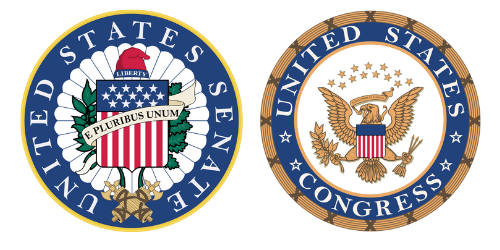
Last week, we reported that Senator Mike Braun (R-IN) blocked efforts on the U.S. Senate floor to unanimously confirm both Gilbride’s nomination and Looman’s nomination in the waning days of the 117th Congress. Meanwhile, Kotagal’s nomination had long stalled in the Senate following a deadlocked Senate Health, Education, Labor, and Pensions (HELP) Committee vote which had failed to move her out of the Committee on May 25, 2022. Senate Majority Leader Chuck Schumer (D-NY) could have nonetheless brought Kotagal’s nomination to the Senate for a full floor vote. However, despite strenuous efforts and a long campaign on her behalf, Majority Leader Schumer and other Democrats could not muster 50 Democrat Senators to vote to confirm her nomination. Consequently, all three nominations timed out and died at the end of the 117th Congress.
NOTE: The Democrat Senate majority has, of course, increased (as of January 3) from the 50-50 Senate split between Democrats and Republicans in the 117th Congress to 48 Democrats and 3 Independents who caucus with the Democrats (for a total of 51 “Democrats”) in the new 118th Congress. President Biden will find it much easier and expeditious for two different reasons to now advance his nominees through the Senate confirmation process and get them confirmed so they may take their appointed seats in the Executive Branch of the federal government.
First, Senate committee assignments will no longer be evenly split between the parties as they were in the 117th Congress because of the then even (50-50) split of Senators on the Senate Floor. Rather, Senate Committees will be staffed by the Democrat leadership of the U.S. Senate with eight (8) Democrats and seven (7) Republicans. This staffing will reduce the likelihood of “deadlocked” 7-7 votes which characterized the 117th Congress, stranding candidates “in Committee.” “Stranded” nominees who failed to report out of Committee were then left in the 117th Congress for Senate Majority Leader Schumer to decide whether he had sufficient time, Democrat Senate votes, and mindshare to “throw those nominees stranded in Committee a “life preserver” and pull them out of Committee and up to the Senate for Floor votes he thought Democrats could win to confirm the candidate’s nomination.
Note: Ms. Kotagal’s nomination is an example of a candidate who not only deadlocked in Committee, but who Senator Schumer also could not persuade his fellow Democrats to confirm. If Ms. Kotagal now successfully navigates the Senate’s confirmation process, it will most likely be because of the second point (below) which is also new with the 118th Congress given how the U.S. Senate is now configured.
Second, with 51 “Democrat” Senators, and with a need to find only 50 Senate votes to confirm a Presidential nominee for a federal judgeship or a federal agency “political appointment,” Majority Leader Schumer can now suffer the loss of one Democrat Senator and still get the nominee confirmed. (Once 50, but only 50, U.S. Senators vote to confirm a candidate, the Senate is technically “deadlocked.” However, the Rules of the Senate anticipate this scenario and allow the Vice President (in this case Kamala Harris (D-CA)), sitting as the President of the Senate, to cast the “tie-breaker” vote.
So, be prepared for a steady and long stream of Presidential nominees to again start parading through the U.S. Senate Committees and then on to the Senate for a full Floor vote. About 25% of President Biden’s senior level political appointees subject to the “advice and consent” of the U.S. Senate (and who the Senate must confirm before they take office), have not yet been confirmed (179 out of 670 appointment vacancies remain after the first two years of the President’s term in office: 491 have been confirmed). At the same time, there are currently 86 federal judicial appointment vacancies also competing for nominees and the Senate’s time, attention and confirmation. Context: There will likely be about 175 Senate Legislative Days in calendar 2023 during which the U.S. Senate will be in session. It takes about three days to process a nominee for a Senate Floor vote over Republican opposition ONCE the Senate Committees send the candidate to the U.S. Senate. Have you ever watched molasses drip…? 175 days. Over 250 candidates to confirm (and 10% of our almost 900 federal judges retire each year). 3-days per cycle. Do the math. Have you ever seen a broken transmission on a car?
Compare the happier times with landslide Presidential victories with clear mandates to the Congress from the voters: first-term Reagan Administration (1981): a Republican Senate confirmed all political appointees within 30 days of the date the Chief Justice swore the President in. Clinton Administration (1993): a Democrat Senate took just 41 days. Ah, “the good ole’ days”!
Tuesday, January 3, 2023: House Republicans Proposed Procedural Rules That Would Allow Legislative Amendments to Axe Specific Programs/Agencies or Agency Officials
“Holman Rule” Would Also Allow Cuts to Salary of Specific Federal Employees
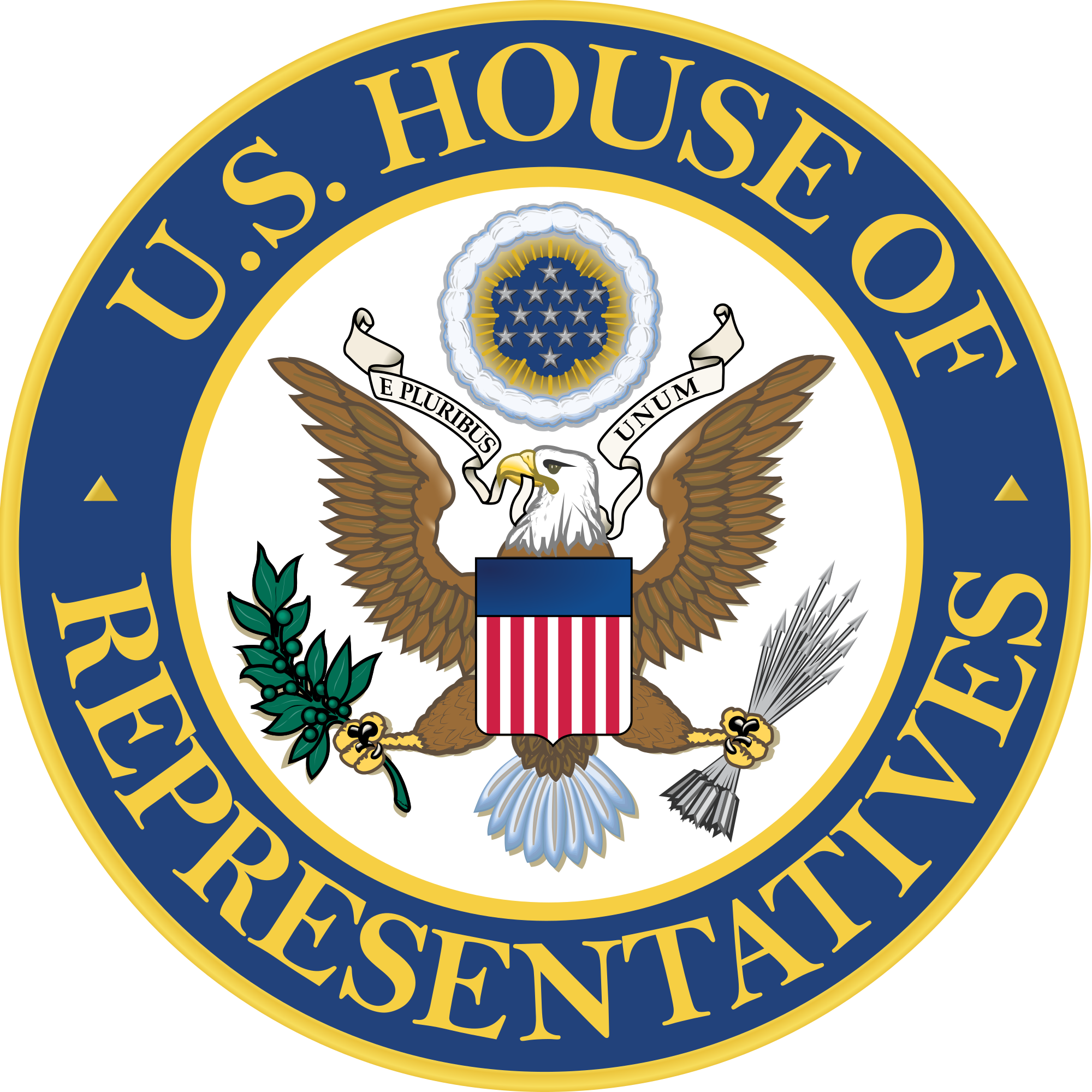
How It Works
Using the Holman Rule, Representatives may propose amendments regarding staffing cuts or salary reductions without input from the House Appropriations Committee. Importantly, the Rule requires that such cuts target specific entities, and the amendments cannot be contingent on future events. Moreover, the specific spending bill for which a Representative proposes an amendment must cover the targeted agency. While Representatives may debate the amendments on the floor for a limited amount of time, agency officials cannot testify before Congress to respond to such amendments.
Because the Democrats remain in control of the Senate and Presidency, any such amendments in the House are less likely to become law (but we have watched lots of big budget bills and Defense Authorizations get buttered with many riders and legislative earmarks. Nevertheless, implementation of the Holman Rule could create obstructions and delays to the passage of appropriations bills.
The Holman Rule originated in 1876, and Congress dropped the bulk of it in 1983. The 115th Congress revived it briefly in 2017 and 2018. Now that the House Republicans of the 118th Congress have confirmed Kevin McCarthy (R-CA) as The Speaker of The House to succeed Nancy Pelosi (D-CA), – after 15 rounds of voting over four days – they can move forward on this Resolution.
Tuesday, January 3, 2023: Increased Employment for People with Disabilities Likely Due to Pandemic Operational Changes, New USDOL Blog Asserted
However, Significant Employment Gaps Remain, Especially for Disabled Women

“People with disabilities have re-entered the labor force in greater numbers and have even surpassed the pre-pandemic level,” the two economists reported. “This encouraging trend improves the historically persistent, substantial gaps between workers with and without disabilities,” they pointed out.
Pandemic Restrictions Led to Similar Employment-Populations Decline for Those With, & Without Disabilities
As employers implemented COVID-19 pandemic on-site work restrictions, from February 2020 to April 2020, the employment-population ratio declined similarly for people with and without disabilities, the economists observed. The employment-population ratio for people with disabilities aged 16+ declined from 19.1 percent in February 2020 to 17.4 percent in April 2020. For those without disabilities, the decline was from 65.9 percent to 59.5 percent. For the age range 16-64, the declines were similar at 8.0 percent for people with disabilities and 7.8 percent for people without disabilities. The employment-population ratio for people with disabilities fully recovered, however, by August 2021 at 19.4 percent and has remained above its pre-pandemic level since. Meanwhile, the ratio for people without disabilities has not recovered but has been at or above 65 percent since February 2022. The employment-population ratio for all workers ages 25-54 is at its pre-COVID-19 pandemic ratio, the authors reported.
Two Recent Publications Support Hypothesis
The blog also referenced two recent publications:
- “How Has COVID-19 Impacted Disability Employment,” a paper published by the National Bureau of Economic Research noted that the expansion of telework may have contributed to the increased employment among disabled workers; and
- “Employment of Persons with a Disability: Analysis of Trends during the COVID-19 Pandemic,” a brief published by the Department of Labor’s Office of Disability Employment Policy, also supports this hypothesis. Yet, the brief pointed out that a disproportionate share of people with disabilities are still employed in occupations that are less amenable to telework, such as production, transportation, material moving, and service jobs.
Gender Disparities Also Changed
The pandemic downturn and recovery exacerbated gender disparities generally, and those differences were reflected in the lower employment share of women with disabilities relative to men with disabilities. However, women’s employment share has picked up in recent months, the authors said. The employment-population ratio for men ages 16-64 with disabilities fully recovered in July 2021 at 33.2 percent. Among women ages 16-64, the employment-population ratio for those with disabilities fully recovered in April 2021 at 29.7 percent. In recent months, this ratio for women with disabilities has been nearly one-fifth higher than it was prior to the pandemic.
Practical Takeaway: The COVID-19 pandemic, with its forced changes to the way we work, may have driven work accommodations beneficial to individuals with a disability. (Why didn’t we think of this?) Perhaps going forward, we can change the driver of change to be purposeful rather than the side-car by-product of an occurrence we did not plan (like the COVID-19 virus outbreak). You could be the change and not have to wait for the next virus-driven pandemic.
Wednesday, January 4, 2023: U.S. BLS Reported Slight Decrease in Job Openings for November, Little Change in Hires & Total Separations
Heads-up for Recruiters and Talent Acquisition personnel
In November 2022, the number of nonfarm sector job openings decreased slightly to 10,458,000, compared to the revised figure of 10,512,000 in October (a decrease of 54,000), the U.S. Bureau of Labor Statistics (BLS) stated in its Job Openings and Labor Turnover Summary (JOLTS) Report for November 2022. The rate did not change at 6.4 percent compared to the 6.4 percent in October (revised figure), but that was 0.9 percentage points lower than its peak in March 2022. Hires were 6.1 million, down a little from 6.0 million in October. Total separations went up slightly to 5.9 million compared to 5.8 million in October.
U.S. Department of Labor Chief Economist Joelle Gamble pointed out on Twitter that: “JOLTS is a smaller survey than [the Jobs Report]. There are almost always revisions to estimates as more data comes in. October openings were revised upward to 10.5 million & November’s decrease of 54K is based on the revised level.”
She posted the following chart to illustrate how job openings remain on a downward trend that began after the series peak in March 2022.
“The biggest declines were in accommodation and food services (-89K), finance and insurance (-75K) and health care and social assistance (-62K). Professional and business services saw a 212K increase in openings in November.” Economist Gamble reported.
Not Much Change in Number of Hires and Separations
The number of hires was 6,055,000 and the rate was 3.9 percent, which was little change from 6,111,000/4.0 percent in October. Hires increased in health care and social assistance (+74,000)
“There were also fewer new hires in November than in October,” Economist Gamble tweeted. “Though, health care and social assistance, notably, saw a 74K over the month increase in hires,” she pointed out.
Total separations changed little at 5,870,000 compared to October’s 5,756,000; the rate held steady at 3.8 percent. Within separations, the number – 4,173,000 – and rate -2.7 percent – of voluntary quits went down a smidge, compared to October’s 4,047,000 and 2.6 percent.
The number of layoffs and discharges was 1,350,000 million, down slightly from 1,445,000 in October. The rate did not change at 0.9 percent.
The number of other separations was 347,000 in November, compared to 347,000 in October. The rate held steady at 0.2 percent.
Three-Month Comparison Chart of Job Openings vs Jobs Filled
Our table below compares numbers from the JOLTS and Jobs (“Economic Situation”) Report from the last three months of available comparison data. The numbers reflect the revised figures, as opposed to the original report numbers.
| Report | September | October | November |
| JOLTS Report
Job Openings |
10,687,000
(407,000 more than August*) |
10,512,000
(175,000 less than September) |
10,458,000
(54,000 less than October) |
| Jobs Report
Jobs added |
263,000 | 263,000 | 256,000 |
*August Job Openings were 10,280,000
Note that the JOLTS Report for December 2022 is scheduled to be released on Wednesday, February 1, 2023.
Upcoming Changes
Effective with the release of the January 2023 JOLTS Report on March 8, 2023, the JOLTS estimates will be revised to incorporate the annual updates to the Current Employment Statistics employment data and the JOLTS seasonal adjustment factors, the BLS announced. Not seasonally adjusted data and seasonally adjusted data from January 2018 forward are subject to revision. In accordance with annual practice, additional historical data may be revised as a result of the benchmark process.
Also effective with the release of the January Report data (in March), JOLTS will begin publishing two new tables presenting annual average job openings levels and rates.
In addition, JOLTS will modify its method to calculate annual estimates for hires and separations rates. Annual rates will be computed as annual averages, instead of as annual totals, to make the estimates more helpful for data users and to be consistent with other BLS programs.
JOLTS will also introduce several changes to the monthly news release tables beginning with the news release for January data. Two tables displaying JOLTS data by size class will be added to the news release: one for seasonally adjusted estimates and the other for not seasonally adjusted estimates. JOLTS will also introduce over-the-month change columns for levels and rates to tables 1 through 6.
NAICS System Update
Also effective with the January report data (scheduled for release in March), JOLTS will adopt the 2022 version of the North American Industry Classification System (NAICS), which has a minimal impact on the published JOLTS data series, the BLS stated.
Economist Gamble explained further in a Twitter thread:
“The goal of NAICS 2022 is to modify or create industry categories that reflect new, emerging, or changing activities and technologies. About 10 percent of employment in the payroll survey will be reclassified into different industries because of the NAICS 2022 update.
The update will mean major revisions to the retail trade and information sector content and coding but minor revisions to mining & logging, manufacturing, wholesale trade, financial activities, and other services – which is a sector title[,] not a catch-all term.
Prior to NAICS 2022, the last NAICS update was released in February 2018 (NAICS 2017). Reviews of NAICS are scheduled to happen every 5 years. You can learn more about the NAICS 2022 implementation schedule, across BLS releases, here: https://bls.gov/bls/naics-implementation-schedule.htm”
Wednesday, January 4, 2023: White House Office of Management & Budget Released Fall 2022 Regulatory Agenda
Three OFCCP Final Rules & Two Proposals on the Way!

As with the Spring 2022 Regulatory Agenda, there were no EEOC items listed in the Fall 2022 Regulatory Agenda. NOTE: That will change if and when the President can get a third Democrat Commissioner to the EEOC confirmed through the Senate nomination and confirmation process. See our first story today about the President’s renomination of Ms. Kotagal to be that EEOC Commissioner.
Below, we discuss the OFCCP items and highlight a few other Rules of interest.
All Covered Federal Government Contractors: Wet your writing pens. It is going to be an active Spring to write comments to OFCCP. OFCCP is about to embark on two significant real Rulemakings which can create Rules with the “binding force and effect of law.”
OFCCP set April 2023 for NPRM to “Modernize” Supply & Service Contractor Regulations

March 2023 Now Anticipated Date for NPRM to Require Reporting of Subcontractors
OFCCP slated March 2023 for its NPRM on “Notification of Supply and Service Subcontract Awards” (RIN: 1250-AA15) – moved back two months from the previous regulatory agenda plan. The proposal would “add provision(s) to the regulations implementing Executive Order 11246 requiring contractors to provide notice to OFCCP when they award supply and service subcontracts. The notice would include information currently unavailable to OFCCP, enabling it to schedule supply and service subcontractors for compliance evaluations.”
The regulatory citation listed for this Rule is “Not Yet Determined,” but the legal authority is listed as Executive Order 11246.
Final Rule on Rescinding Trump-era Religious Exemption Now Two Months Overdue
We previously reported that, on July 6, 2022, OFCCP submitted to the OMB its Final Rule (RIN: 1250-AA09) to rescind, in its entirety and without replacement, the Trump Administration’s December 8, 2020, Final Rule, “Implementing Legal Requirements Regarding the Equal Opportunity Clause’s Religious Exemption.” As with the Spring 2022 Agenda, the Fall Agenda lists November 2022 as the anticipated date for OFCCP’s Final Rule. Thus, the agency is now two months behind its schedule.
Notice of the proposed rescission was published in the Federal Register on November 9, 2021, and the public comment period closed on December 9, 2021. According to OFCCP, “[t]he rescission would ensure that the religious exemption contained in Section 204(c) of Executive Order 11246 is consistent with nondiscrimination principles of Title VII of the Civil Rights Act of 1964, as amended.” The regulatory citation for this item is 41 CFR §60-1.
We discussed this item at length in June 2021: “Here it Comes: OFCCP Plans to Modify Its PDN And Religious Exemption Rules” and November 2021: “OFCCP Published its Draft Proposal to Rescind the Trump OFCCP Religious Exemption Rule, and Not Replace It.”
OFCCP Expects PDN Final Rule Publication Two Months Ahead of Previous Schedule
Last week, we reported that “OFCCP Submitted to OMB Its Final Rule on “Pre-Enforcement Notice & Conciliation Procedures” on December 21, 2022. The Fall 2022 Regulatory Agenda now lists March 2023 as the publication rule – two months ahead of the May 2023 date OFCCP had last year listed in its Spring 2022 Agenda.
Also known as the “PDN Rule” with PDN standing for “Pre-Determination Notice,” this proposed Rule (RIN: 1250-AA14) would “modify certain provisions” in the November 2020 Final “PDN Rule” and make other related changes to the pre-enforcement notice and conciliation process. On March 22, 2022, OFCCP published its NPRM on this item in the Federal Register. Shortly after its publication, John Fox discussed the NPRM in a bonus blog, “OFCCP’s Proposed NPRM Walks Backwards Promising Less Transparency in Audits and Unknown, But Different (to come), Evidentiary Standards in Discrimination Investigations.”
The comment period ended on April 21, 2022, and OMB received twelve comments. The agency cited 41 CFR §§60-1, -2, -4, -20, -30, -40, -50, -300, & -741 as the regulatory authority for this Rule.
March 2023 Set for Final “Technical Amendments” to Update Jurisdictional Thresholds & Remove Gender Assumptive Pronouns
This Rule (RIN: 1250-AA16) will make technical corrections to update jurisdictional thresholds for the Vietnam Era Veterans’ Readjustment Assistance Act and Section 503 of the Rehabilitation Act. The thresholds were adjusted for inflation by the Federal Acquisition Regulation Council, pursuant to section 807 of the Ronald Reagan National Defense Authorization Act, codified at 41 USC §1908, OFCCP explained. It will also correct OMB control numbers for OFCCP information collection requirements and remove gender assumptive pronouns. The regulatory citation for this item is 41 CFR §§60-1, 2, 4, 20, 30, 40, 300, 741, & 999.
The target publication date for this “Final Action” is March 2023 – four months behind the November 2022 date listed in the previous regulatory agenda.
WHD Proposal on Certain Exemptions Forthcoming, But Behind Schedule
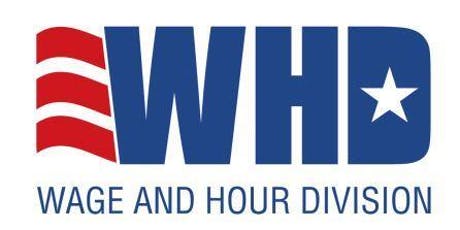
Independent Contractor Final Rule Slated for May 2023
The WHD published an NPRM in the Federal Register on Thursday, October 13, 2022 that would apply a six-part “Totality of Circumstances” Test to determine whether a “worker” (neutral term) is an “employee” or an “ independent contractor” under the Fair Labor Standards Act. We discussed this NPRM in detail here. The comment period on this proposal closed on December 13, 2022. The agency has slated May 2023 for publication of its Final Rule.
Nondisplacement of Qualified Workers Under Service Contracts Final Rule
On July 15, 2022, the WHD published its NPRM on “Nondisplacement of Qualified Workers Under Service Contracts” (RIN: 1235-AA42). The Division intends the Rule to keep individuals employed after a federal service contract has expired (the Service Contract Act of 1965, as amended, covers most service contracts over $250,000). As proposed, the Rule would generally require contractors and subcontractors who work on covered federal service contracts to place clauses into successor contracts involving the “same or similar” work for existing services deals to provide employees a right of first refusal for positions under the contract for which those employees are qualified. For more details, see our story here.
The public comment period closed on August 15, 2022. The OMB’s website shows that the WHD plans to publish an NPRM to “Analyze Comments.” However, the WHD is now a month behind its December 2022 target date for that publication.
Updating the Davis-Bacon and Related Acts Regulations Final Rule Expected Next Month
The WHD published its NPRM to update the Davis-Bacon and Related Acts regulations (RIN: 1235-AA40) on May 13, 2022. The comment period ended on June 13, 2022. Our story here detailed that proposal. The WHD now anticipates a February 2023 publication of its Final Rule.
NLRB anticipates publishing its Final Joint Employer Rule in August 2023
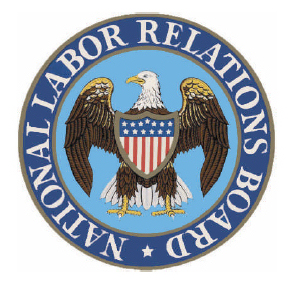
Election Protection Final Rule proposal slated for August 2023 publication
The NLRB published its NPRM on “Fair Choice and Employee Voice” on November 4, 2022. The proposal would revise the representation election procedures located at 29 CFR §103 (RIN: 3142-AA22), with a focus on amendments it issued on April 1, 2020. It would rescind the current Final Rule adopted by the prior Board majority in 2020. The proposed Rule would rescind and replace the 2020 amendments to the Board’s Rules governing blocking charges and the voluntary-recognition bar doctrine and rescind the amendment governing proof of majority support for labor organizations representing employees in the construction industry.
The comment period on that proposal is still open and will conclude on January 17, 2023. Our story here explains the proposal. The NLRB has now set August 2023 as the target for publication of its Final Rule.
Thursday, January 5, 2023: U.S. Federal Trade Commission Announced Proposal to Ban Employers from Using Worker Non-Compete Agreements
The U.S. Federal Trade Commission (FTC) released a very controversial proposed Rule that would: (1) prohibit employers (nationwide) from using non-compete clauses in their contracts with employees, independent contractors and “volunteers,” and (2) require employers to rescind existing non-competes and actively inform workers that they are no longer in effect. The proposal would also make it illegal for an employer to represent to a worker that the worker is subject to a non-compete where the employer lacks a good faith basis to believe that the worker is subject to an enforceable non-compete clause. Moreover, the proposed Rule would preempt all state laws providing lesser protections.
The proposed FTC Rule has also raised eyebrows because of its expansive breadth: it would also apply to independent contractors and anyone who works for an employer, whether paid or unpaid, as noted above. The proposed rule would generally not apply to other types of employment restrictions, such as non-disclosure agreements. However, the agency warned in a corresponding press release that other types of employment restrictions could be subject to the proposed Rule if they are so broad in scope that they function as non-competes. The corresponding press release also contains links to related documents, including Commissioner statements.
While the FTC has not yet published the Notice of Proposed Rulemaking (NPRM) in the Federal Register, the Commission posted the contents of the forthcoming publication on its website. Once the agency publishes the NPRM in the Federal Register, the public will have a 60-day period to comment. According to the FTC’s Fall 2022 Regulatory Agenda (White House Office of Management and Budget RIN: 3084-AB74), the Commission is only one-month behind on its planned publication date.
The FTC will be particularly interested in public comments addressing whether: (1) franchisees should be covered by the rule; (2) senior executives should be exempted from the rule, or subject to a rebuttable presumption rather than a ban; and (3) low- and high-wage workers should be treated differently under the rule.
Justifications for the Proposal
The FTC also posted a “Fact Sheet” detailing its justifications for the proposal. “Employers often justify using non[-]competes with their workers to protect confidential information and to get the most out of their investments in training and capital,” the agency noted in this document. “But the record to date shows that in California, North Dakota and Oklahoma—three states in which employers cannot enforce non[-]compete clauses— industries that depend on trade secrets and other key investments have still flourished. This shows that employers have other ways of protecting these investments,” the Commission reasoned.
In addition, the FTC estimates that the Rule would: (1) increase workers’ earnings by nearly $300 billion per year; (2) save consumers up to $148 billion annually on health care costs; and (3) double the number of companies founded by a former worker in the same industry.
2021 Biden Executive Order Requested FTC to Consider This Type of Rule
On July 9, 2021, President Biden issued Executive Order (E.O.) 14036, entitled, “Promoting Competition in the American Economy.” Among other provisions, E.O. 14036 requested the FTC to consider how it may be able to restrict the use of non-compete clauses and other types of agreements by businesses that limit worker mobility. We discussed E.O. 14036 in some detail here.
Recent Related FTC Actions
On September 15, 2022, the FTC issued a 17-page “Policy Statement on Enforcement Related to Gig Work.” The statement noted the FTC’s position that “[non-compete] provisions may violate Section 1 of the Sherman Act and the FTC Act’s prohibition on unfair methods of competition.” Further, “the Commission recognizes that companies may be able to effectuate the same harmful results [by] imposing a variety of other restraints that restrict worker mobility,” the statement cautioned. Accordingly, the FTC stated that it will “investigate contractual limitations, such as liquidated damages clauses or nondisclosure agreements, that may be excessive or overbroad and effectively operate as non-compete provisions.”
We reported in July that the FTC and the National Labor Relations Board signed a Memorandum of Understanding (MOU) to focus on “Anticompetitive and Unfair Labor Practices.” Among the areas of mutual interest that the agencies pinpointed in the MOU are “one-sided and restrictive contract provisions, such as non-compete and nondisclosure provisions.”
Friday, January 6, 2023: Economy Added 223k Jobs in December; Unemployment Rate Remained at 3.5%
The economy added 223,000 total nonfarm payroll jobs in December, down from the 256,000 (revised figure) number in November, the U.S. Bureau of Labor Statistics (BLS) reported in its latest monthly jobs report. The December unemployment rate was 3.5 percent, down slightly from 3.6 percent in November. Notable job gains occurred in leisure and hospitality, health care, construction, and social assistance.
Importantly, BLS noted that:
“The change in total nonfarm payroll employment for October was revised down by 21,000, from +284,000 to +263,000, and the change for November was revised down by 7,000, from +263,000 to +256,000. With these revisions, employment gains in October and November combined were 28,000 lower than previously reported. (Monthly revisions result from additional reports received from businesses and government agencies since the last published estimates and from the recalculation of seasonal factors.)”
Among the unemployed, the number of long-term unemployed (those jobless for 27 weeks or more) declined by 146,000 to 1.1 million in December. This measure is down from 2.0 million a year earlier. The long-term unemployed accounted for 18.5 percent of all unemployed persons.
The employment-population ratio increased by 0.2 percentage point over the month to 60.1 percent. The labor force participation rate was little changed at 62.3 percent. Both measures have shown little net change since early 2022, BLS observed. These measures are each 1.0 percentage point below their values in February 2020, prior to the COVID-19 pandemic.
The number of persons employed part time for economic reasons, at 3.9 million, changed little in December. The number of those not in the labor force who currently want a job fell by 352,000 to 5.2 million in December and is little different from its February 2020 level of 5.1 million. These individuals were not counted as unemployed because they were not actively looking for work during the 4 weeks preceding the survey or were unavailable to take a job.
Among those not in the labor force who wanted a job, the number of persons marginally attached to the labor force declined by 231,000 to 1.3 million in December. These individuals wanted and were available for work and had looked for a job sometime in the prior 12 months but had not looked for work in the 4 weeks preceding the survey. The number of discouraged workers, a subset of the marginally attached who believed that no jobs were available for them, numbered 410,000 in December, essentially unchanged from the previous month.
Long-term Unemployment Numbers
The numbers for total unemployment are reported in a chart here. Unemployment (seasonally adjusted) for 5 to 14 weeks remained steady at 28.4 percent. The rate for unemployment of 15 to 26 weeks was 14.3 percent, up from 13.7 percent in November. The unemployment rate for 27 weeks and over was 18.5 percent, down from 20.3 percent in November. The number of long-term unemployed (those jobless for 27 weeks or more) was 1.1 million in December, down from 1.2 million in November. The long-term unemployed accounted for 18.5 percent of all unemployed persons in December, down from 20.3 percent in November.
Revision of Seasonally Adjusted Household Survey Data
The Jobs Report presents statistics from two monthly surveys. The household survey measures labor force status, including unemployment, by demographic characteristics. The establishment survey measures nonfarm employment, hours, and earnings by industry. The BLS noted that: “Seasonally adjusted household survey data have been revised using updated seasonal adjustment factors, a procedure done at the end of each calendar year. Seasonally, adjusted estimates back to January 2018 were subject to revision.”
Thus, the BLS included unemployment rates for January 2022 through November 2022 (as originally published and as revised) at the end of this week’s report.
Three-month Jobs Report Comparison Data
The White House Council of Economic Advisor’s Blog reported that:
“Job growth in October, November, and December averaged 247,000 jobs per month (Figure 1), a slowdown from the prior three months of July, August, and September (366,000 jobs per month on average) and the last three months of 2021 (637,000). Since monthly numbers can be volatile and subject to revision, the Council of Economic Advisers prefers to focus on the three-month average rather than the data in a single month, as described in a prior CEA blog.”
To illustrate, the Council shared the following chart:
Major Worker Groups
Among the major worker groups, the unemployment rate for Whites fell to 3.0 percent in December. The jobless rates for adult men (3.1 percent), adult women (3.2 percent), teenagers (10.4 percent), Blacks (5.7 percent), Asians (2.4 percent), and Hispanics (4.1 percent) showed little or no change over the month.
Our chart below further details the rate changes among the major worker groups:
|
The Employment Situation – December 2022 |
||||
| Unemployment Rate | October 2022 | November 2022 | December 2022 | Feb 2020 Pre-Pandemic |
| National (Seasonally adjusted) |
3.7% | 3.6% | 3.5% | 3.5% |
| White | 3.3% | 3.3% | 3.0% | 3.0% |
| Black | 5.9% | 5.7% | 5.7% | 6.0% |
| Asian | 2.9% | 2.6% | 2.4% | 2.5% |
| Hispanic (Seasonally adjusted) |
4.2% | 4.0% | 4.1% | 4.4% |
| Native Hawaiians & Other Pacific Islanders | 3.1% | 4.5% | 4.4% | 2.7% |
| Two or More Races (Not seasonally adjusted) |
5.5% | 4.9% | 6.0% | 6.1% |
| Men (20+) | 3.3% | 3.3% | 3.1% | 3.2% |
| Women (20+) (Seasonally adjusted) |
3.4% | 3.3% | 3.2% | 3.1% |
| Veteran (Not seasonally adjusted) |
2.5% | 2.8% | 3.2% | 3.7% |
| Individuals with Disabilities (Not seasonally adjusted) |
7.4% | 5.8% | 5.0% | 7.8% |
BLS has additional, interactive graphs available here.
See Also
- President Biden’s remarks
- U.S. Secretary of Labor Marty Walsh’s remarks
- USDOL Chief Economist Joelle Gamble’s Twitter thread of observations
- White House Counsel of Economic Advisers’ blog
Looking Ahead:
Upcoming Date Reminders
Monday, January 9, 2023: Comments due on US EEOC proposal to eliminate counting employees to determine filing “type” for EEO-1 Survey Component 1 – https://www.regulations.gov/document/EEOC-2022-0005-0001
Tuesday, January 17, 2023: Comments due on OFCCP’s Proposed Changes to Disability Self-Identification Form to Update Preferred Language for Specific Disabilities – https://www.regulations.gov/commenton/OFCCP-2022-0003-0004
Friday, January 20, 2023: Deadline to submit comments on OFCCP’s Proposed Changes to Its Supply & Service Contractor ICRs, Including Use of Portal to Submit Revised Scheduling Letter & Revised Itemized Listing Responses – https://www.regulations.gov/commenton/OFCCP-2022-0004-0001
Thursday, February 2, 2022: Deadline to submit initial comments on NLRB’s proposed changes to NLRA regulations (previous January 3 deadline extended) – https://www.regulations.gov/commenton/NLRB-2022-0002-0001
Thursday, February 16, 2022: Deadline to submit reply comments in response to initial comments on NLRB’s proposed changes to NLRA regulations (previous January 17 deadline extended) – https://www.regulations.gov/commenton/NLRB-2022-0002-0001
Wednesday, April 12 – Friday, April 14, 2023: DEAMcon23 Chicago (Registrations open now; Agenda now available here!)
THIS COLUMN IS MEANT TO ASSIST IN A GENERAL UNDERSTANDING OF THE CURRENT LAW AND PRACTICE RELATING TO OFCCP. IT IS NOT TO BE REGARDED AS LEGAL ADVICE. COMPANIES OR INDIVIDUALS WITH PARTICULAR QUESTIONS SHOULD SEEK ADVICE OF COUNSEL.
SUBSCRIBE.
Compliance Alerts
Compliance Tips
Week In Review (WIR)
Subscribe to receive alerts, news and updates on all things related to OFCCP compliance as it applies to federal contractors.
OFCCP Compliance Text Alerts
Get OFCCP compliance alerts on your cell phone. Text the word compliance to 55678 and confirm your subscription. Provider message and data rates may apply.

